Sorry for the long question. I'm having a difficult time trying to explain my confusion.
I have a positive point charge$\ Q_1 =+q$ at the origin and a negative point charge $\ Q_2 = -2q$ at $\ x=2$

Suppose I'm trying to find where the electric field is zero and where the electric potential is zero. Let's also limit these locations to only those that lie on the $x$ axis.
To find where the electric field is zero it will be
$$\mathbf{\overrightarrow{E}}_{net} = \mathbf{\overrightarrow{E}}_1 + \mathbf{\overrightarrow{E}}_2 = 0$$
Here's where I get confused. Because I know the electric fields add together in between the charges and the magnitude of the negative charge is greater than the positive charge so the electric field will not be zero to the right of the negative charge, the only place on the x axis where the electric field will be zero is to the left of the positive charge.
So since the field due to $Q_1$ will point in the $-x$ direction and the field from $Q_2$ will point in the positive $x$ direction and $|E| = k\displaystyle\frac{Q}{r^2}$ I would set up the equation thus:
$$E_2 – E_1 = k\frac{\lvert Q_2\rvert}{r_2^2} – k\frac{\lvert Q_1\rvert}{r_1^2} = k\frac{\lvert -2q\rvert}{(2+x)^2} – k\frac{\lvert q\rvert}{x^2} = 0$$
and rearranging I get
$$\begin{align}
\frac{x^2}{(2+x)^2} &= \frac{1}{2} \\
\frac{x}{2+x} &= \frac{1}{\sqrt{2}} \\
\sqrt{2}x &= 2+x \\
x(\sqrt{2}-1) &= 2 \\
x &= \frac{2}{\sqrt{2}-1} = 4.83
\end{align}$$
This is the correct magnitude but the wrong sign. It should be $-4.83$.
In an example I saw they set it up as:
$$E_1 – E_2 = k\frac{\lvert Q_1\rvert}{r_1^2} – k\frac{\lvert Q_2\rvert}{r_2^2} = k\frac{\lvert q\rvert}{(x)^2} – k\frac{\lvert -2q\rvert}{(x-2)^2} = 0$$
This leads to the correct answer $-4.83$ but I'm not sure why it's $r = x-2$ in the denominator of $E_2$. That would make sense to me if the point was going to be to the right of $Q_2$ So that's the first part of my question. How do you choose the right equation for $r$ the distance from the charge. ($x-2$?, $x+2$?, $2-x$?)
And similarly, to find where the electric potential is zero and knowing $V = k\frac{Q}{r}$, how do I choose the right value for $r$ for each of the charges?
Best Answer
Pay close attention to how you defined $x$: it's not the coordinate of the desired point on the $x$ axis, it's how far left of the positive charge that point is. So when your equation tells you $x = 4.83$, that means the desired point is $4.83$ units left of the positive charge. But, presumably the question you've been asked wants the coordinate of the point, not how far left of the positive charge it is. So the last step in solving (which you skipped) is to figure out, if you have a point that is $4.83$ units left of the positive charge, what is the $x$-coordinate of that point?
In the example you mentioned at the end, they defined $x$ differently, such that is is the $x$-coordinate of the desired point. That's why that equation gets you directly to the coordinate.